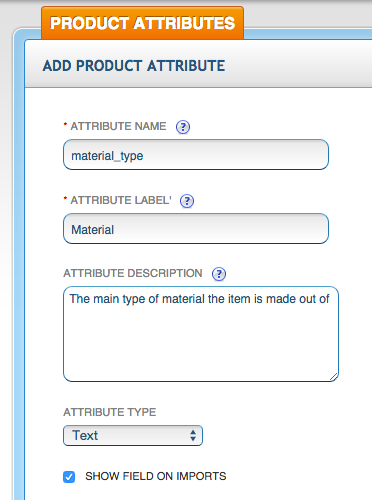Product attributes are fields of data used to describe and classify your products. SalesWarp offers default and custom product attributes. Attributes are grouped into attribute sets that can be assigned to specific products or groups of products.
Attribute Sets
Select Product Attributes under the Products menu. Your attribute sets are listed to the left. The Default attribute set will be open.

Within an attribute set, attributes can be split up into groups. These groups help to organize your product view/edit page - each group represents a tab on the product view/edit page. The default attribute set is split up into the following groups: Product Info, which includes basic attributes such as Product Type, Product Name and Product Description; Meta Info, which includes meta tags for the product; Price, which includes price fields such as MSRP and Unit Price; Images, for product images; Dimensions; and Reorders, which includes information for adding the product to a purchase order, such as Reorder Unit, Unit Size and Reorder Threshold.
It's easy to add a new group to the default set, or to create a new attribute set. When you create a new attribute set, all of the default attributes will pre-populate. If you want to remove attributes, use the red X or simply drag and drop the attribute into the "Unused Attributes" area.
When should you use Attribute Sets?
Attribute sets are useful for grouping products together that might have the same specific attribute types. For example, if you're selling Eyeglasses, you might have specific requirements for product attributes such as Lens Type or UV Protection. If you're selling furniture or home decor, you might have specific requirements for attributes such as Material Type or Scent.
Where do these requirements originate? Usually from Amazon, Ebay or another online marketplace. But using specific attribute types can help with site search and merchandising on your own website as well. Do some research about the products you're selling and determine if you can simply include the information in a generic product description or bullet point, or if the product information requires its own attribute.
Attribute sets are used throughout SalesWarp to filter your products down to a manageable set for importing, viewing, publishing and exporting. Keep this in mind when creating your attribute sets.
Add a new product attribute
To add a new custom attribute, click on the blue +New Attribute button. Here you can give the attribute a database-friendly name, a display name and a description that will display when a user hovers over the attribute.

Select an Attribute Type. With Drop Down you can add drop down options, Enum is a Yes/No selection, Text is a simple text field, Date (can be used for sale date or date product was last modified), Multi Select allows you to select multiple drop down options at once, Integer is a number and Varchar is a combination of letters and numbers.
Choose whether or not the attribute will be included in the list of attributes at Product Import, and whether or not the attribute will be required to create a new product. Save the attribute, and then add it to an attribute set/group by dragging and dropping from the list of Unused Attributes. Now the attribute will be visible on the product view/edit page for products that have that attribute set assigned to them.
Using Custom Product Attributes
When are custom product attributes most helpful? Usually for meeting the requirements of online marketplaces like Amazon and Ebay, but using specific attribute types can help with site search and merchandising on your own website as well. One particular use case is to create attributes for bullet points 1 through 5, to map to the bullet points offered by Amazon in the product description.
Note that using attributes such as Size and Color will only be a data field attached to the product. In order to create configurable products that use Size and Color as variations, you must import the variations using Product Import.
Comments